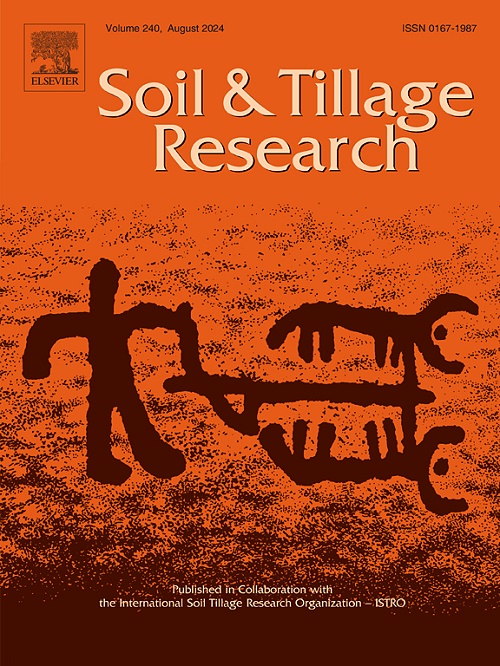Linking microbial metabolism and ecological strategies to soil carbon cycle function in agroecosystems
IF 6.1
1区 农林科学
Q1 SOIL SCIENCE
引用次数: 0
Abstract
Revealing regional-scale differences in microbial community structure and metabolic strategies across different land use types and soil types and how these differences relate to soil carbon (C) cycling function is crucial for understanding the mechanisms of soil organic carbon (SOC) sequestration in agroecosystems. However, our understanding of these knowledge still remains unclear. Here, we employed metagenomic methods to explore differences in microbial community structure, functional potential, and ecological strategies in calcareous soil and red soil, as well as the relationships among these factors and SOC stocks. The results showed that the bacterial absolute abundance and diversity were higher and the fungal absolute abundance and diversity were lower in calcareous soil than in red soil. This may be attributed to stochastic processes dominated the assembly of bacterial and fungal communities in calcareous soil and red soil, respectively. This in turn was closely related to soil pH and Ca2 + content. Linear discriminant analysis showed that genes related to microbial growth and reproduction (e.g., amino acid biosynthesis, central carbon metabolism, and membrane transport) were enriched in calcareous soil. While genes related to stress tolerance (e.g., bacterial chemotaxis, DNA damage repair, biofilm formation) were enriched in red soil. The great difference in soil properties between calcareous soil and red soil may be the cause of this result. Compared with red soil, the higher soil pH, SOC, and calcium and magnesium content in calcareous soil increased the bacterial absolute abundance and diversity, thus increasing the SOC sequestration potential of microorganisms, but also increased the decomposition of organic carbon by fungi, thus increasing the SOC loss potential. However, the bacterial absolute abundance and diversity were much higher than that of fungi. Therefore, soil carbon sequestration potential was still greater than its loss potential in karst agroecosystems. Agricultural disturbance intensity may be the main factor affecting these relationships. Overall, these findings advance our understanding of how soil microbial metabolic processes are related to SOC sequestration.
农业生态系统中微生物代谢和生态策略与土壤碳循环功能的关联
揭示不同土地利用类型和土壤类型间微生物群落结构和代谢策略的区域尺度差异,以及这些差异与土壤碳循环功能的关系,对于理解农业生态系统中土壤有机碳(SOC)固存机制至关重要。然而,我们对这些知识的理解仍然不清楚。本研究采用宏基因组学方法探讨了钙质土壤和红壤土壤微生物群落结构、功能潜力和生态策略的差异,以及这些因素与有机碳储量的关系。结果表明:钙质土壤细菌绝对丰度和多样性高于红壤,真菌绝对丰度和多样性低于红壤;这可能是由于在钙质土壤和红壤中,细菌群落和真菌群落的聚集分别由随机过程主导。这与土壤pH和Ca2 +含量密切相关。线性判别分析表明,与微生物生长和繁殖相关的基因(如氨基酸生物合成、中心碳代谢和膜运输)在钙质土壤中富集。而与胁迫耐受性相关的基因(如细菌趋化性、DNA损伤修复、生物膜形成)在红壤中富集。钙质土与红壤土壤性质的巨大差异可能是造成这一结果的原因。与红壤相比,钙质土壤pH、有机碳和钙镁含量较高,增加了细菌的绝对丰度和多样性,从而增加了微生物对有机碳的固存潜力,但也增加了真菌对有机碳的分解,从而增加了有机碳的损失潜力。但细菌的绝对丰度和多样性远高于真菌。因此,喀斯特农业生态系统土壤固碳潜力仍大于其损失潜力。农业扰动强度可能是影响这些关系的主要因素。总的来说,这些发现促进了我们对土壤微生物代谢过程如何与有机碳封存相关的理解。
本文章由计算机程序翻译,如有差异,请以英文原文为准。
求助全文
约1分钟内获得全文
求助全文
来源期刊

Soil & Tillage Research
农林科学-土壤科学
CiteScore
13.00
自引率
6.20%
发文量
266
审稿时长
5 months
期刊介绍:
Soil & Tillage Research examines the physical, chemical and biological changes in the soil caused by tillage and field traffic. Manuscripts will be considered on aspects of soil science, physics, technology, mechanization and applied engineering for a sustainable balance among productivity, environmental quality and profitability. The following are examples of suitable topics within the scope of the journal of Soil and Tillage Research:
The agricultural and biosystems engineering associated with tillage (including no-tillage, reduced-tillage and direct drilling), irrigation and drainage, crops and crop rotations, fertilization, rehabilitation of mine spoils and processes used to modify soils. Soil change effects on establishment and yield of crops, growth of plants and roots, structure and erosion of soil, cycling of carbon and nutrients, greenhouse gas emissions, leaching, runoff and other processes that affect environmental quality. Characterization or modeling of tillage and field traffic responses, soil, climate, or topographic effects, soil deformation processes, tillage tools, traction devices, energy requirements, economics, surface and subsurface water quality effects, tillage effects on weed, pest and disease control, and their interactions.
 求助内容:
求助内容: 应助结果提醒方式:
应助结果提醒方式:


